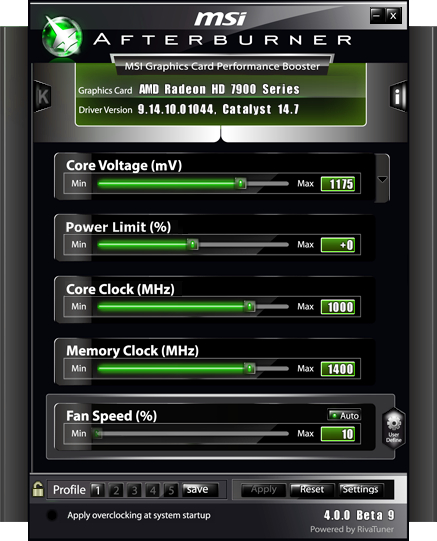Come da titolo vi segnalo l'uscita della nuova release beta di Afterburner
La nuova beta porta in dote un change log da urlo!!
Changes list v.4.0.0 beta9 includes:
• Various parts of hardware monitoring module have been pumped up to improve hardware monitoring usability and flexibility:
o Added layered monitoring graphs rendering mode. Now you may right click source graph in monitoring window, select “Attach” in the context menu then point to destination graph to attach source graph to it and create a group of layered graphs. This feature allows you to render as many layered graphs on the same grid as you wish. The colors of graphs in layered rendering mode can be customized independently of each other so you can easily identify them
o Added multi-column monitoring graphs rendering mode. Now you can adjust the number of graph columns in “Active monitoring graphs” section in “Monitoring” tab
o Added “Override graph name” option to “Monitoring” tab. Now you can rename the graphs displayed in hardware monitoring window
o Monitoring history buffer size is no longer defined by monitoring window width. Now pre-history buffer size is fixed and stores the last 3600 samples (1 hour for 1000ms polling period) for each graph
o Improved tray icon monitoring module:
o Now you can select either text mode or barchart indicator mode for each value displayed in tray icon. Barchart indicator mode can be extremely useful for visualizing data like GPU / CPU usage
o Improved Logitech keyboard LCD monitoring module:
o Ported to new Logitech API to provide support for newer Logitech LCD displays
o Added support for color LCD display of Logitech G19/G19s keyboards
o Added graph mode support for color LCD display of Logitech G19/G19s keyboards. Now in addition to previously available text mode you can optionally select graph mode and see exact copy of MSI Afterburner’s monitoring graphs displayed directly inside the keyboard LCD. You can also press “Menu” soft button on your Logitech G19/G19S keyboard to toggle between text and graph modes dynamically in realtime
o Added acceleration support to LCD scrolling implementation
o Added larger 8x12, 10x12, 12x12 and 12x16 fonts support for text mode
• Added “Regional settings” section to “User Interface” tab:
o Temperature format settings allow you to switch between Celsius and Fahrenheit format for monitored temperatures. Please take a note that this setting affects temperature readouts only. Hardware related temperature adjustments (e.g. fan speed to temperature mapping curve for all cards or temperature target adjustment for NVIDIA Kepler series) are always being displayed and adjusted in Celsius for maximum unification, safety and compatibility
o 12 hours / 24 hours time format settings allow you to configure time format for On-Screen Display and hardware monitoring window
• Added “Enable low-level IO driver” option to the “Compatibility properties” section in “General” tab
• Added SLI sync performance limit graph for release 340 and newer NVIDIA drivers
• Display device enumeration implementation has been modified slightly to allow monitoring Intel iGPUs when low-level IO driver is not enabled
• Improved handshaking algorithm reduces the risk of seeing multiple running instances of child processes (e.g. RTSS)
• Optimized hardware polling for NVIDIA graphics cards
• Optimized hardware polling for multi-GPU systems
• Added SVI2 voltage control support via AMD ADL SDK to provide compatibility with future graphics cards
• Added automatic prerecording settings to “Videocapture” tab. When you enable automatic mode prerecording session is being started automatically on each 3D application startup. Please take a note that in this case you can still use video prerecord hotkey to stop then manually restart prerecording session if necessary
• Drastically improved skin engine:
o Improved skin compiler gives more detailed error messages when skin compilation fail due to error in some source image file
o Source image file format is no longer limited to 24-bit BMP files only. Now skin compiler supports all possible bit depths for BMP format and fully supports PNG format with alpha channel
o Added built-in bitmap effect for extracting alpha-channel from PNG image files
o Skin format has been upgraded to v1.3. New format supports alpha channel based transparency for skinned window, allowing skin designers to define semi-transparent skin areas, apply antialiasing to the skin window edges and so on
o Added new skinned window composition modes support and “Skin composition mode” settings to “User interface tab”. New settings allows you to use one of the following modes:
o Traditional mode – suits best for backward compatibility with existing skins and performance testing
o Layered mode with colorkey - provides much faster rendering of skins with non-rectangular window shape and additionally allows you to adjust transparency of skinned window
o Layered mode with alpha – provides per-pixel alpha channel support and advanced visual effects for compatible skins and also allows you to adjust transparency of skinned window
o Skin format reference guide has been updated to v1.7 to document these changes
o Improved implementation of rollback to default skin
o Full skins cross-compatibility with other overclocking applications based on RivaTuner engine. Special GUI transformation layer allows you to use the skins designed for third party RivaTuner based overclocking applications and makes the process of migration to MSI Afterburner from such overclocking tools much more comfortable for you. You can keep the look and feel of your preferred overclocking application and at the same time enjoy extended MSI Afterburner’s features including full range of supported graphics cards, industry leading powerful and robust monitoring module, flexible video recording features and many more
• RivaTuner Statistics Server has been upgraded to v6.1.3
download link:
- MEGA (l'ho uppato io): https://mega.co.nz/#!g1BhBa7J!rTPiED...NXjhB2OX8hW_nE
- sito ufficiale: MSI Afterburner 4.0.0 Beta 9 Download









 Rispondi quotando
Rispondi quotando